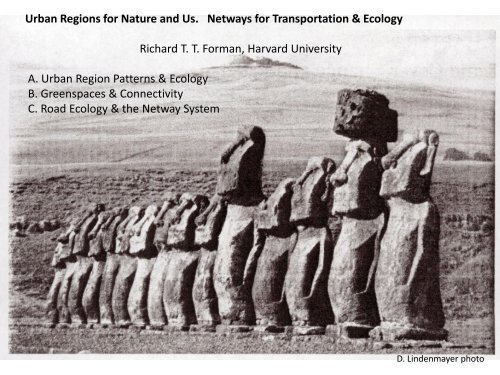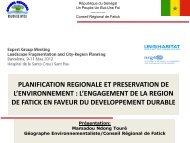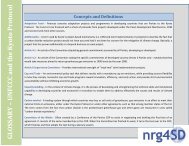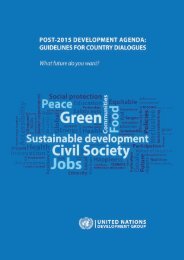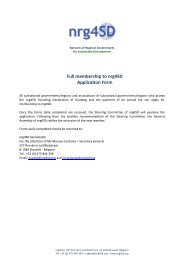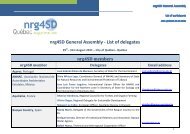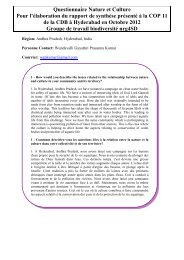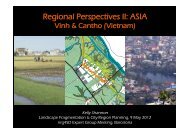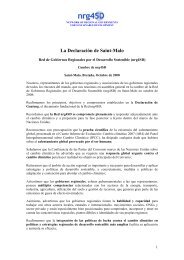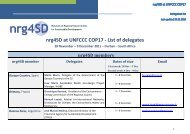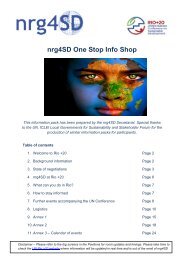Urban Regions for Nature and Vs. Netways for ... - nrg4sd.org
Urban Regions for Nature and Vs. Netways for ... - nrg4sd.org
Urban Regions for Nature and Vs. Netways for ... - nrg4sd.org
You also want an ePaper? Increase the reach of your titles
YUMPU automatically turns print PDFs into web optimized ePapers that Google loves.
<strong>Urban</strong> <strong>Regions</strong> <strong>for</strong> <strong>Nature</strong> <strong>and</strong> Us. <strong>Netways</strong> <strong>for</strong> Transportation & Ecology<br />
A. <strong>Urban</strong> Region Patterns & Ecology<br />
B. Greenspaces & Connectivity<br />
C. Road Ecology & the Netway System<br />
Richard T. T. Forman, Harvard University<br />
D. Lindenmayer photo
Cities Today <strong>and</strong> Tomorrow<br />
Half the world (3 billion people) is urban<br />
In one generation (by 2030): 5 billion urban people<br />
<strong>Urban</strong> poor doubles from 1 to 2 billion<br />
>20 megacities today (1 in 1975; almost 30 in 2030)<br />
Fastest growth in number of large cities: East Asia<br />
Fastest growth rate is in cities ¼ to ½ million population<br />
Increasing number of cities<br />
Greatest growth expected near coasts<br />
Area of cities increases faster than population<br />
Greatest area increase (due to sprawl): North America<br />
Easily visible “<strong>Urban</strong> Tsunami” sweeps swiftly <strong>and</strong><br />
powerfully across the l<strong>and</strong>
Our future…?
Atlas of Global Conservation 2010
McDonald, R.I. et al. 2009. L<strong>and</strong>scape & <strong>Urban</strong> Planning. 93.
Collinge, S.K. 2009.<br />
Ecology of<br />
Fragmented<br />
L<strong>and</strong>scapes.
URBAN REGION<br />
Our Place<br />
Our Nourishment<br />
Our Home Range<br />
Our Future
R. Forman. 2008. <strong>Urban</strong> <strong>Regions</strong>.
R. Forman. 2008. <strong>Urban</strong> <strong>Regions</strong>.
R. Forman. 2010. In Ecol. <strong>Urban</strong>ism.
<strong>Urban</strong> <strong>Regions</strong>:<br />
Policy, Planning<br />
R. Forman. 2008. <strong>Urban</strong> <strong>Regions</strong>.
<strong>Urban</strong><br />
Region:<br />
Barcelona
Major Themes<br />
<strong>Urban</strong> Region Plan Highlighting Natural Systems & Their Uses<br />
<strong>Nature</strong><br />
The emerald network: Large natural areas, &<br />
Diverse connection types<br />
Food production<br />
Major food areas: Large productive agricultural l<strong>and</strong>scapes<br />
Agriculture-nature parks<br />
Concentrated greenhouses<br />
Water<br />
Water supply <strong>for</strong> nature & us: Both scarcity & floods<br />
Stormwater, sewage, & wetl<strong>and</strong>s<br />
Streams, rivers, & blue-green ribbons: Water quality, & riparian vegetation<br />
Industries alongside, & contrasting rivers<br />
Built systems<br />
Highways, congestion, & trucking center<br />
Underpasses/overpasses <strong>for</strong> people & wildlife<br />
Rail system, commuters, & airport<br />
Built areas<br />
Pinpoint good growth areas, & no-growth areas<br />
Large, medium, & small industries<br />
Municipalities & other repeated patterns<br />
The large floodplain park
R. Forman. 2004. Mosaico territorial.
R. Forman. 2004. Mosaico territorial.
Pla territorial metropolita de Barcelona. 2010.
R. Forman. 2008. <strong>Urban</strong> <strong>Regions</strong>.
von Stulpnagel, A. et al. 1990. In <strong>Urban</strong> Ecology.
Effects of two giants: nature <strong>and</strong> transportation<br />
Habitat loss<br />
Roadkills<br />
Road barrier to wildlife movement<br />
Small pops. In fragmented habitats<br />
Degraded roadside habitats<br />
Traffic noise effects<br />
Altered wetl<strong>and</strong>s<br />
Soil erosion<br />
Sedimentation of water-bodies<br />
Fuel cost & shortage<br />
Greenhouse gas emissions<br />
Deteriorated road surfaces<br />
Deficient bridges & culverts<br />
Traffic jams & wasted time<br />
Stormwater flooding & pollution<br />
Communities split by highways<br />
Air pollutants from traffic<br />
Accidents
Yun Wang photo
-<br />
Sperling, D. & D. Gordon. 2009. Two Billion Cars.
van Bohemen, H.D. 2005. Ecological Engineering…
SUSTAINABLE TRANSPORTATION<br />
…?
Forman, R.T.T. & D.Sperling. 2011. Solutions.
Forman, R.T.T. & D. Sperling. 2011. Solutions.
Gustafsson, J. 2009. Proc. IEEE 97.
The New York Times. Sept. 26, 2010
Forman, R.T.T.<br />
& D. Sperling.<br />
2011.<br />
Solutions.
Vuchic, V.R. 2007. <strong>Urban</strong> Transit Systems…
Vuchic, V.R. 2007. <strong>Urban</strong> Transit Systems…
TIMING & COSTS<br />
Last trans<strong>for</strong>mation 1900-25<br />
Horsepower to motor vehicles<br />
Muddy/dusty roads to asphalt roads<br />
Now<br />
Years 1-5<br />
Review ecology dimensions. Review engineering dimensions. Map valuable<br />
nature <strong>and</strong> busy highways. Identify renewable energy sources. Identify materials,<br />
manufacturers, contractors. Initiate large pilot-project areas. Build local public<br />
interest. Build policymaker support. Conduct cost/benefit analyses.<br />
Years 5-10<br />
Build & monitor pilot projects<br />
Years 10-25<br />
Exp<strong>and</strong> pilot projects. Construct netway system in all nature priority areas.<br />
Gauge public usage/dem<strong>and</strong> <strong>for</strong> expansion of netways as the basic widespread<br />
transportation system.<br />
Costs<br />
Planning. Construction of netways. Energy generation. Producing pods.<br />
Conversion of highways to green multi-use corridors at varied rates.
Gustafsson, J. 2009. Proc. IEEE 97.
Benefits of the Netway System<br />
Restores terrestrial/aquatic habitat & biodiversity.<br />
Reconnects l<strong>and</strong> <strong>for</strong> wildlife movement & natural water flows.<br />
Decreases polluted aquatic ecosystems & fish loss.<br />
Meets more clean-water-supply needs.<br />
Reduces flooding.<br />
Reduces fossil-fuel oil <strong>and</strong> energy consumption.<br />
Decreases polluting particles/aerosols/gases.<br />
Decreases greenhouse gas emissions.<br />
Eliminates rebuilding of numerous bridges & culverts.<br />
Recycles today’s vehicles, asphalt, guardrails, & roadbed fill.<br />
Enhances local food production near communities.<br />
Enhances trail recreation opportunities near communities.<br />
Huge Stimulus/Boon <strong>for</strong> Industry & Jobs<br />
New research & development.<br />
Auto manufacturers make new vehicle types.<br />
Netway components constructed.<br />
Large engines & service center facilities built.<br />
Investments in wind, solar, & geo energy production.<br />
Investments in battery development.
Mold the l<strong>and</strong> so nature <strong>and</strong> people both thrive long term.<br />
Forman, R.T.T. & D.Sperling. 2011. Solutions.


